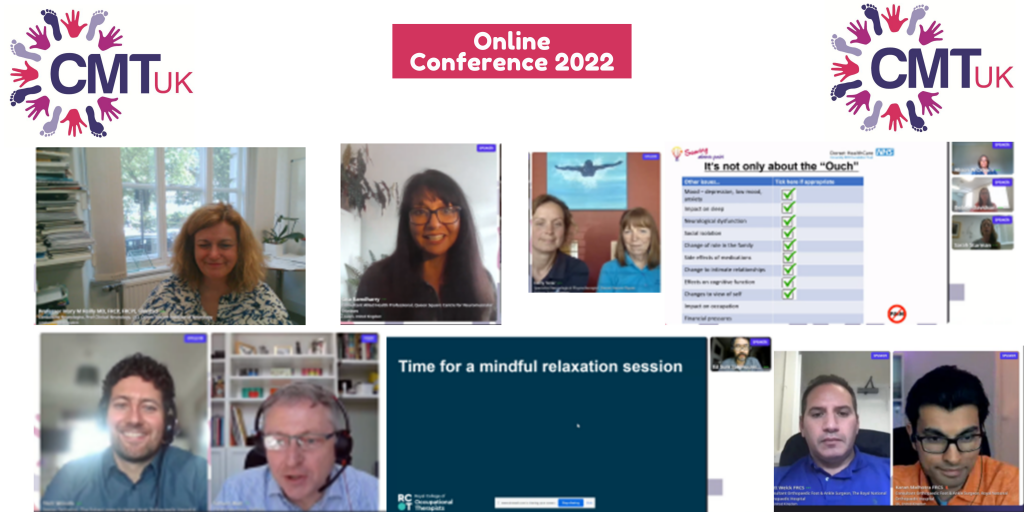CMTUK Conference 2022 – A Post-Conference Report
Conference details: The CMTUK Conference 2022 was held over 6th and 7th May 2022 and was streamed virtually.
Report by: Simon Bull, Chief Executive, CMTUK
CMTUK is a UK charity, working to support those living with Charcot-Marie-Tooth disease. CMTUK’s conference, organised annually, was open to everyone interested in CMT including CMTUK members, non-members and medical professionals. Speakers shared the latest knowledge, research and findings in the field of CMT disease. Highlights of this year’s programme are outlined below.
Day 1 of the CMTUK Conference 2022
Professor Mary Reilly
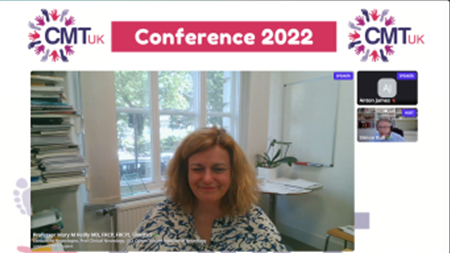 After an introduction and welcome from Paul Fleming (Chair of the Board) and Simon Bull (Chief Executive), Professor Mary Reilly (Professor of Neurology at UCL Queen Square Institute of Neurology and patron of CMTUK) gave a talk about ‘the challenges in CMT therapy development’.
After an introduction and welcome from Paul Fleming (Chair of the Board) and Simon Bull (Chief Executive), Professor Mary Reilly (Professor of Neurology at UCL Queen Square Institute of Neurology and patron of CMTUK) gave a talk about ‘the challenges in CMT therapy development’.
Professor Reilly explained that there are over 100 causative genes for CMT, a family of diseases. To get a pharmaceutical therapy, you need a diagnosis, candidate therapies, clinical trials of the therapies and response of outcome measures. There is currently a 77% diagnostic rate at Queen Square. Over the last few years, the UK has moved to a UK-wide neuropathy panel, done by genome sequencing, which has really improved diagnosis in the UK. Mary talked about how she is very interested in the research to close the 23% diagnostic gap. The kind of therapies are genetic gene therapy (there have been massive strides forward in this type of therapy over the past years due to advances in technology), target pathogenesis of disease and pathway therapies. According to clinicaltrials.gov, there are 455 trials happening for CMT; 82 of these actively recruiting trials; and 1 therapeutic trial. Out of the 100 genes or more; CMT1A is still the most common (61%), due to an extra copy of PMP22 and is a slowly progressive and life disabling condition. Mary is starting a new ‘sense trial’ in June 2022 within the UK, the Hereditary Sensory Neuropathy Serine Trial. Mary is also part of a team working on an international level on clinical trials for a newly found rare gene, called SORD. CMT outcome measures in slowly progressive diseases is done via clinical, neurophysiology and scales. It is also being measured by MRI muscle, blood biomarkers and skin biopsies. Once they are more advanced, therapies are aimed at stopping the progression of the condition. Over the next few years, results will be in for several trials, including Pharnext phase III, serine in HSN1, and Aldose reductase inhibitor in SORD and possible gene silencing trial in CMT1A. One problem is that there isn’t currently a national registry of people with CMT to help with trials, although Mary and her team are starting to develop this, with the help of CMTUK.
Tom Woods
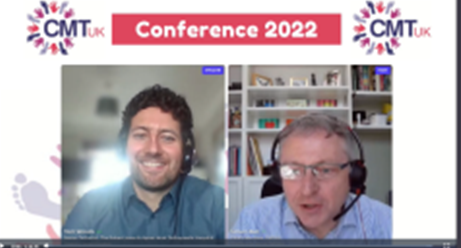 Tom Woods, Senior Orthotist at The Robert Jones and Agnes Hunt Orthopaedic Hospital in Oswestry, shared orthotic principals to enhance function and improve the life of individuals with CMT. Tom’s speciality is in gait analysis, AFOs and KAFOs. At the hospital, there are 15 orthotists (13 full time equivalent), the biggest orthotist team in the country which also includes onsite orthotic manufacturing facilities. The hospital also includes the ORLAU (Orthotic Research and Locomotor Assessment Unit). Tom talked about foot orthoses including FFO (functional foot orthosis), TCI (total contact inlay/ insole), simple inlays and cradles and how well-fitting footwear is really important; orthotists can provide advice about appropriate footwear or if required, measure for bespoke orthotic footwear. AFOs (ankle foot orthoses) are used to control motion around the foot and ankle and can be designed to isolate motion in particular planes to optimise biomechanical function or reduce pain. Tom shared that out of 126 CMT feet examined by Vinci et al (2002), 10% had isolated severe to mild foot drop; 68% had severe to mild foot drop with excessive supination/ pronation of the foot; 21% had severe foot drop, excessive supination/pronation (rolling in/out of ankle) and plantarflexor (pushing ankle down) failure. Tom then went on to discuss the various orthotics available to help with each of these.
Tom Woods, Senior Orthotist at The Robert Jones and Agnes Hunt Orthopaedic Hospital in Oswestry, shared orthotic principals to enhance function and improve the life of individuals with CMT. Tom’s speciality is in gait analysis, AFOs and KAFOs. At the hospital, there are 15 orthotists (13 full time equivalent), the biggest orthotist team in the country which also includes onsite orthotic manufacturing facilities. The hospital also includes the ORLAU (Orthotic Research and Locomotor Assessment Unit). Tom talked about foot orthoses including FFO (functional foot orthosis), TCI (total contact inlay/ insole), simple inlays and cradles and how well-fitting footwear is really important; orthotists can provide advice about appropriate footwear or if required, measure for bespoke orthotic footwear. AFOs (ankle foot orthoses) are used to control motion around the foot and ankle and can be designed to isolate motion in particular planes to optimise biomechanical function or reduce pain. Tom shared that out of 126 CMT feet examined by Vinci et al (2002), 10% had isolated severe to mild foot drop; 68% had severe to mild foot drop with excessive supination/ pronation of the foot; 21% had severe foot drop, excessive supination/pronation (rolling in/out of ankle) and plantarflexor (pushing ankle down) failure. Tom then went on to discuss the various orthotics available to help with each of these.
Pain Management
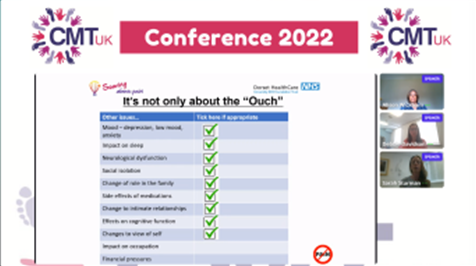 Specialist Pain Nurse Alison Wickham and Specialist Physiotherapist Sarah Sturman from the Dorset pain management service at Dorset HealthCare University talked about the science of pain, and how to manage pain on a day-to-day basis. They talked about the four pillars of pain management: learning about pain; building a healthy lifestyle; doing what matters; developing emotional well-being. The more information someone has about their pain, the better they can manage it. Living with pain has much wider impacts on our lives, such as mood, sleep, social isolation, impact on occupation, etc. Pain management is about empowering people to take back control of their pain.
Specialist Pain Nurse Alison Wickham and Specialist Physiotherapist Sarah Sturman from the Dorset pain management service at Dorset HealthCare University talked about the science of pain, and how to manage pain on a day-to-day basis. They talked about the four pillars of pain management: learning about pain; building a healthy lifestyle; doing what matters; developing emotional well-being. The more information someone has about their pain, the better they can manage it. Living with pain has much wider impacts on our lives, such as mood, sleep, social isolation, impact on occupation, etc. Pain management is about empowering people to take back control of their pain.
Day 2 of the CMTUK Conference 2022
Dr Gita Ramdharry
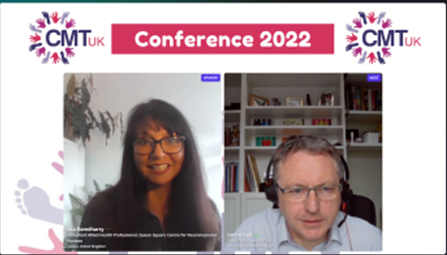 Dr Gita Ramdharry, Consultant Allied Health Professional in Neuromuscular Diseases at the Queen Square / MRC Centre for Neuromuscular Diseases, gave a rehabilitation research update in Charcot Marie Tooth disease, and talked about ways to improve muscle strength, fitness, balance and hand function. She also talked about her strength training research, where it was found that people with CMT can increase their strength through training as well as other research undertaken into fitness, balance and hand function. She also shared the results of a survey about factors affecting engagement in exercise, as well as recent research undertaken in balance in CMT, which was funded by CMTUK.
Dr Gita Ramdharry, Consultant Allied Health Professional in Neuromuscular Diseases at the Queen Square / MRC Centre for Neuromuscular Diseases, gave a rehabilitation research update in Charcot Marie Tooth disease, and talked about ways to improve muscle strength, fitness, balance and hand function. She also talked about her strength training research, where it was found that people with CMT can increase their strength through training as well as other research undertaken into fitness, balance and hand function. She also shared the results of a survey about factors affecting engagement in exercise, as well as recent research undertaken in balance in CMT, which was funded by CMTUK.
Ed Sum
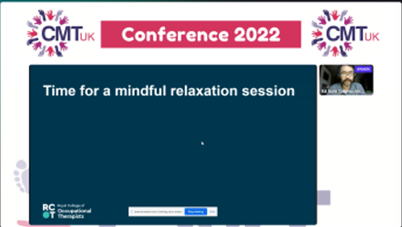 Ed Sum is an occupational therapist working in an NHS post covid service at Norfolk Community Health and Care NHS Trust, and is current co-opted co-Chair of the Royal College of Occupational Therapists Specialist Section – Neurological Practice. He talked about ‘what Occupational Therapists can do you for you’ and ‘what is occupational therapy’; what they do; what they can do for people affected by CMT, as well as hosting a live brief relaxation session. OTs think about what matters to you/ how you would like to spend your time; who matters to you; how to best communicate with you; and future possibilities. OTs’ toolbags include rehabilitation, education or training, advice (signpost to services and assistance), health promotion, support, equipment and problem solving together. Some key areas where OTs can specifically help people living with CMT are mobility (walking aid or wheelchair services), driving assessment, hand function (exercises, splints), pain (managing, relaxation, splints), fatigue (managing stamina, rest, recovery, making things easier, pace/ prioritise/ plan), sleep (positioning, sleep hygiene advice), gadgets (equipment to adaptations), support to access education or training, support with employment, mental health (managing stressors, change, self-compassion, relaxation, accessing activities that promote health), and intimacy. Ed mentioned that Occupational Therapists can be accessed via the NHS, usually through a health professional; social services for equipment/ housing adaptations; driving or passenger assessment; social prescribing – accessing groups/ services in the community, via GPs (in England); or private occupational therapy.
Ed Sum is an occupational therapist working in an NHS post covid service at Norfolk Community Health and Care NHS Trust, and is current co-opted co-Chair of the Royal College of Occupational Therapists Specialist Section – Neurological Practice. He talked about ‘what Occupational Therapists can do you for you’ and ‘what is occupational therapy’; what they do; what they can do for people affected by CMT, as well as hosting a live brief relaxation session. OTs think about what matters to you/ how you would like to spend your time; who matters to you; how to best communicate with you; and future possibilities. OTs’ toolbags include rehabilitation, education or training, advice (signpost to services and assistance), health promotion, support, equipment and problem solving together. Some key areas where OTs can specifically help people living with CMT are mobility (walking aid or wheelchair services), driving assessment, hand function (exercises, splints), pain (managing, relaxation, splints), fatigue (managing stamina, rest, recovery, making things easier, pace/ prioritise/ plan), sleep (positioning, sleep hygiene advice), gadgets (equipment to adaptations), support to access education or training, support with employment, mental health (managing stressors, change, self-compassion, relaxation, accessing activities that promote health), and intimacy. Ed mentioned that Occupational Therapists can be accessed via the NHS, usually through a health professional; social services for equipment/ housing adaptations; driving or passenger assessment; social prescribing – accessing groups/ services in the community, via GPs (in England); or private occupational therapy.
Aquatherapy
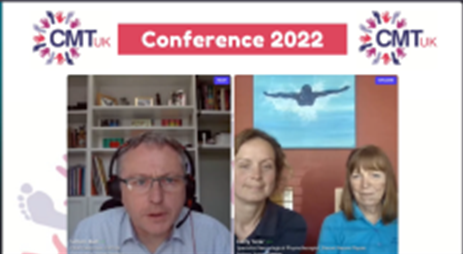 Holly Sizer, Specialist Physiotherapist in Neurology and Rehabilitation, from Dorset Neuro Physio and Fiona Carter Chartered Physiotherapist and owner of Broadstone Physiotherapy and Aquatherapy, talked about the benefits of aquatherapy. The properties of water can help through buoyancy, water resistance, hydrostatic pressure and warm water submersion. The benefits of aquatherapy include relaxation; improves pain relief and reduces muscle spasm; improves circulation to our muscles, organs and brain; increases strength and endurance; improves balance; increases confidence, flexibility and ease of movement; re-education of functional activities; improves cardiovascular fitness. Aquatherapy can be accessed through NHS physio and hydrotherapy services, exercise referral schemes via GPs, aqua-aerobics classes, and via private aquatherapy pools. Holly and Fiona shared that aquatherapy is a safe way for people with CMT to exercise.
Holly Sizer, Specialist Physiotherapist in Neurology and Rehabilitation, from Dorset Neuro Physio and Fiona Carter Chartered Physiotherapist and owner of Broadstone Physiotherapy and Aquatherapy, talked about the benefits of aquatherapy. The properties of water can help through buoyancy, water resistance, hydrostatic pressure and warm water submersion. The benefits of aquatherapy include relaxation; improves pain relief and reduces muscle spasm; improves circulation to our muscles, organs and brain; increases strength and endurance; improves balance; increases confidence, flexibility and ease of movement; re-education of functional activities; improves cardiovascular fitness. Aquatherapy can be accessed through NHS physio and hydrotherapy services, exercise referral schemes via GPs, aqua-aerobics classes, and via private aquatherapy pools. Holly and Fiona shared that aquatherapy is a safe way for people with CMT to exercise.
Research Update
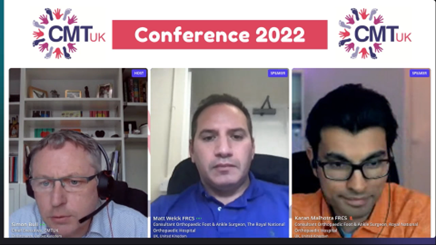 There was also an update from the CMTUK research committee, in delivering the research strategy. This includes launching a research award, with applications now in, as well as setting up a scientific review board, including top professionals across the board of CMT. The next step will be to critique the applications and select the recommended projects to support over the next 2 years. Matt Welck and Karan Malhotra, Consultant Orthopaedic Foot & Ankle Surgeons at The Royal National Orthopaedic Hospital, also gave an update on their research project, made possible by a grant from CMTUK, ‘improving a specific complexity in surgery for CMT foot deformities’. The grant helped to acquire and use specialist software and AI to accurately calculate the shape and position of the bone in 3D, to understand the complex anatomy of the CMT cavus foot. The software helps to plan corrective surgery. This will also help to translate to standard techniques for health professionals, even without access to the software, as well as devising a new classification to guide treatment.
There was also an update from the CMTUK research committee, in delivering the research strategy. This includes launching a research award, with applications now in, as well as setting up a scientific review board, including top professionals across the board of CMT. The next step will be to critique the applications and select the recommended projects to support over the next 2 years. Matt Welck and Karan Malhotra, Consultant Orthopaedic Foot & Ankle Surgeons at The Royal National Orthopaedic Hospital, also gave an update on their research project, made possible by a grant from CMTUK, ‘improving a specific complexity in surgery for CMT foot deformities’. The grant helped to acquire and use specialist software and AI to accurately calculate the shape and position of the bone in 3D, to understand the complex anatomy of the CMT cavus foot. The software helps to plan corrective surgery. This will also help to translate to standard techniques for health professionals, even without access to the software, as well as devising a new classification to guide treatment.
Plus…
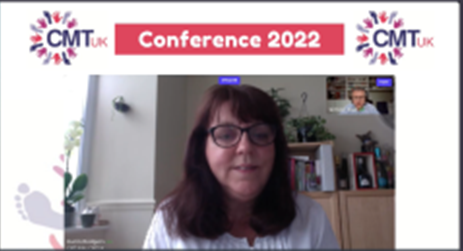 Other talks included an update from Karin Rodgers, a CMTUK Trustee who runs ‘CMT Kids’, who talked about the various activities and get-togethers she organises.
Other talks included an update from Karin Rodgers, a CMTUK Trustee who runs ‘CMT Kids’, who talked about the various activities and get-togethers she organises.
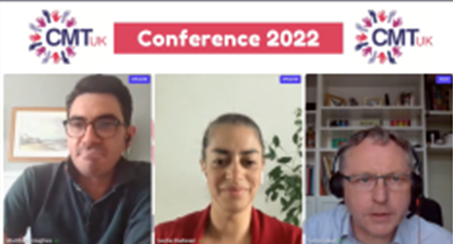 There were also talks from the conference’s sponsors, Dorset Orthopaedic and Special Kids.Company, who shared their CMT-relevant services and products and answered many questions from attendees.
There were also talks from the conference’s sponsors, Dorset Orthopaedic and Special Kids.Company, who shared their CMT-relevant services and products and answered many questions from attendees.
In summary, the conference provided attendees with the latest findings and updates on CMT from prominent CMT authorities.
If you would like to become a CMTUK member, please click here.
Or if you have a CMT query you would like to talk to us about, please do contact us.
